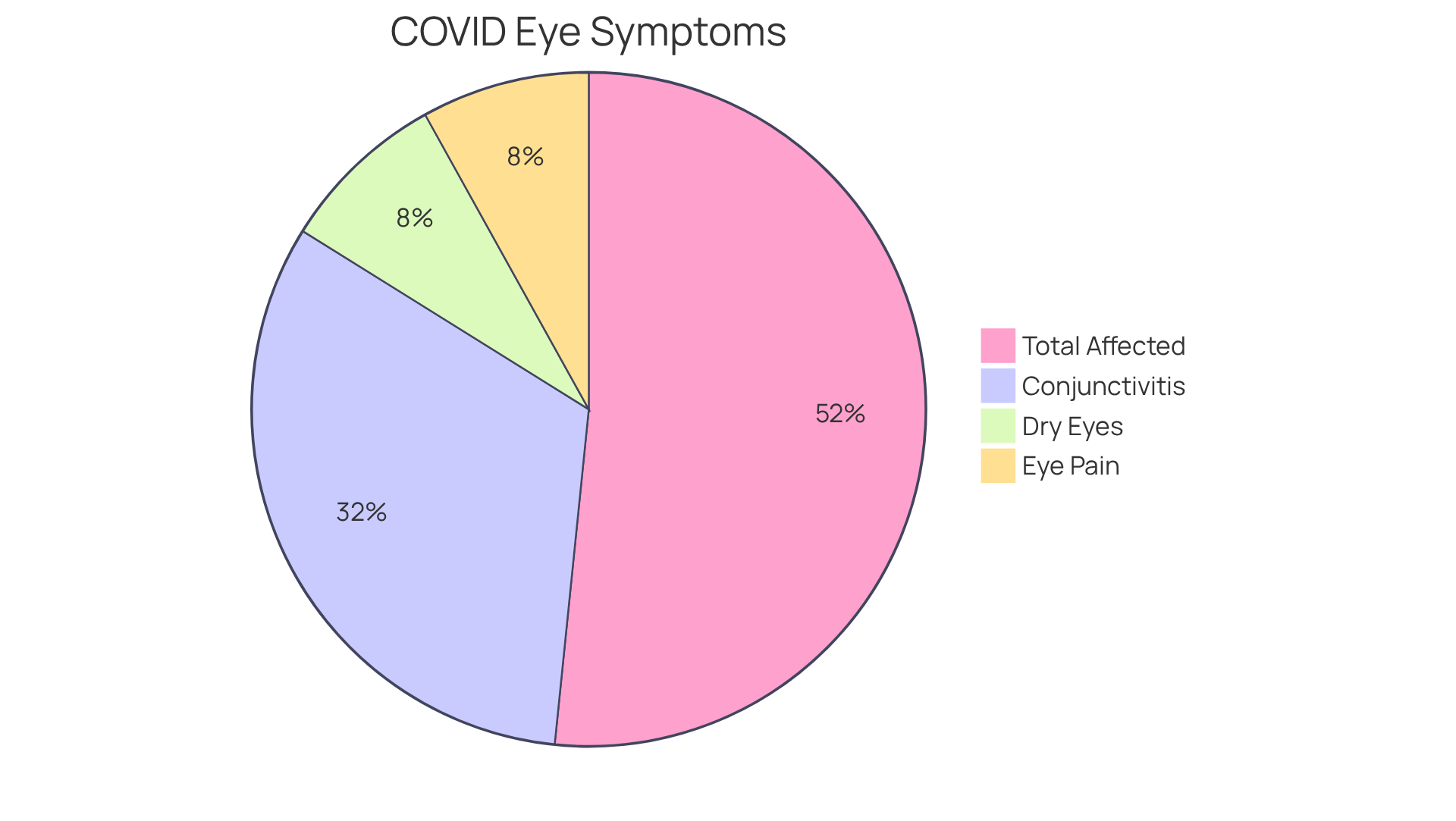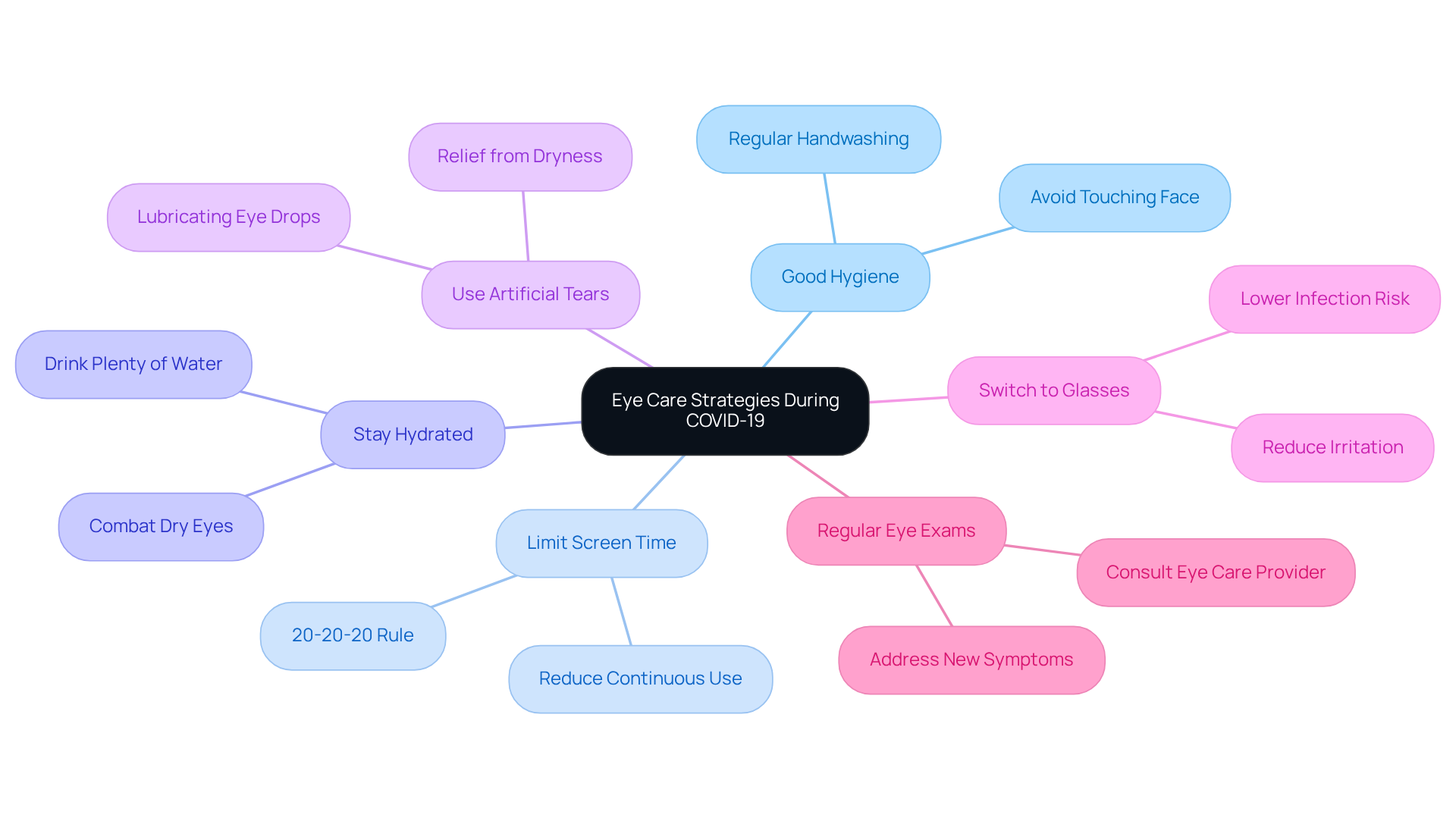Posted by: Northwest Eye in General on August 13, 2025
Overview
This article highlights the symptoms related to COVID-19 that can affect your eye health, often referred to as “covid eyes.” These symptoms include:
- conjunctivitis
- dry eyes
- eye pain
We understand that experiencing these issues can be concerning, and recognizing them is crucial for early detection and management. These symptoms may indicate more serious systemic infections.
It’s common to feel overwhelmed during these times, but we are here to support you. The article also discusses various eye care strategies that can help alleviate these issues during the pandemic. By addressing your eye health, you take a proactive step towards your overall well-being. Remember, you are not alone in this journey; we encourage you to seek care and prioritize your health.
Introduction
The COVID-19 pandemic has unveiled a myriad of health challenges, and we understand that eye health has become an unexpected concern for many. Research indicates that nearly one-third of those infected may experience eye-related symptoms, collectively termed “covid eyes.” These symptoms can range from conjunctivitis to persistent dryness and discomfort. It’s common to feel anxious about these troubling symptoms, and you may wonder: how can one effectively manage and protect their eye health during such uncertain times?
This article delves into the connection between COVID-19 and eye health, offering insights and strategies to ensure optimal ocular care amidst the ongoing pandemic. We are here to help you through this process, providing the support you need to navigate these challenges with confidence.
Explore the Connection Between COVID-19 and Eye Health
The pandemic has been associated with various eye issues, often known as covid eyes, and we understand that this can be concerning. Research suggests that the virus can greatly affect vision health, with approximately 32% of individuals infected with COVID-19 experiencing eye-related issues commonly referred to as covid eyes, including:
- Conjunctivitis (pink eye)
- Dry eyes
- Eye pain
These visual symptoms, commonly known as covid eyes, often stem from the virus’s ability to cause inflammation and its presence in the conjunctival sac, which may act as a potential transmission pathway.
Understanding this connection is crucial for both patients and healthcare providers. It facilitates early detection and management of complications associated with the virus. Significantly, the presence of covid eyes may indicate a more serious systemic infection, necessitating closer observation and thorough care.
It’s common to feel overwhelmed by symptoms like blurred vision, which can signal several eye disorders, including:
- Cataracts
- Diabetic retinopathy
- Dry eyes
These conditions may be exacerbated by what are commonly referred to as covid eyes. We encourage patients facing these issues to promptly, as neglecting these signs can lead to severe health complications.
Case studies have highlighted situations where patients faced persistent covid eyes weeks after their initial signs of infection. This underscores the necessity for ongoing attention to eye health following illness. As the pandemic progresses, identifying and addressing issues related to covid eyes remains a vital part of patient care, especially since some individuals may experience lasting changes in their vision. We are here to help you through this process and ensure your eye health is prioritized.

Identify Key Ocular Symptoms of COVID-19
Key ocular symptoms associated with COVID-19 include:
- Conjunctivitis (Pink Eye): This condition presents with redness, irritation, and discharge from the eyes. We understand that this can be concerning. Research shows that around 31.6% of individuals with the virus display ocular manifestations, with covid eyes being a possible indication such as conjunctivitis. In one case series, 12 out of 38 patients with covid eyes exhibited signs of conjunctival congestion, frequently associated with more severe systemic issues.
- Covid Eyes: Many patients report increased dryness, which may be exacerbated by prolonged screen time during lockdowns, leading to what is commonly referred to as covid eyes. It’s common to feel discomfort in our eyes, known as covid eyes, as we spend more time in front of digital devices.
- Eye Pain or Discomfort: Some individuals experience a sensation of pressure or pain in the eyes, commonly referred to as covid eyes, which can be distressing. This discomfort may be arising from viral infections, such as covid eyes, and we want you to know that you are not alone in this experience.
- Photophobia: Sensitivity to light is another indication that may occur alongside other ocular issues in individuals with covid eyes. This can significantly impact daily activities and overall comfort, particularly for individuals dealing with covid eyes, and we empathize with how challenging this can be.
- Excessive Tearing: Increased tearing can occur as a response to irritation or inflammation, which may be linked to viral infections such as covid eyes.
Identifying these signs is essential, as they may encourage you to pursue testing for the virus, particularly if you are also facing other typical indications like fever or cough, which may include symptoms associated with covid eyes. The American Academy of Ophthalmology has highlighted that while conjunctivitis, known as covid eyes, is a rare symptom compared to cough and fever, it warrants attention in clinical settings, especially for patients presenting with pink eye. Remember, we are here to help you through this process and ensure you receive the care you need.

Implement Strategies for Eye Care During COVID-19
To maintain optimal eye health during the COVID-19 pandemic, we understand that you may have concerns regarding covid eyes. Here are some compassionate strategies to consider:
- Practice Good Hygiene: Regular handwashing is crucial. We encourage you to avoid touching your face, especially around your covid eyes, to reduce the risk of infection, as those areas can act as .
- Limit Screen Time: It’s common to experience digital eye strain from prolonged exposure to screens. In fact, 61% of undergraduate medical students reported this during the pandemic. To help, adhere to the 20-20-20 rule: every 20 minutes, take a 20-second break to look at something 20 feet away.
- Stay Hydrated: Adequate hydration is essential for combating dry eyes, which can be aggravated by indoor heating and air conditioning. Remember to drink plenty of water throughout the day.
- Use Artificial Tears: Over-the-counter lubricating eye drops can provide relief from dryness and irritation, helping to maintain your comfort.
- Switch to Glasses: If you typically wear contact lenses, consider temporarily switching to glasses to reduce irritation and the risk of infection. This small change can make a significant difference in your comfort.
- Regular Eye Exams: We encourage you not to delay necessary eye care appointments. Consult your eye care provider about any concerns, especially if you notice new or worsening symptoms.
By adopting these strategies, you can safeguard your eye health and remain proactive against potential complications related to covid eyes. Remember, we are here to help you through this process.

Conclusion
The intricate relationship between COVID-19 and eye health has become increasingly evident, underscoring the importance of recognizing and addressing symptoms often referred to as covid eyes. We understand that this can be a concerning time for many, and it is essential for both patients and healthcare providers to be aware of these ocular manifestations. By doing so, timely intervention and management of potential complications can be achieved.
Throughout this article, we have explored key symptoms associated with covid eyes, including:
- Conjunctivitis
- Dry eyes
- Discomfort
It’s common to feel overwhelmed by these signs, but identifying them early is crucial, as they may indicate a more serious systemic infection. Additionally, we presented practical eye care strategies—such as maintaining good hygiene and limiting screen time—to help you protect your vision during these challenging times.
Ultimately, prioritizing eye health during the pandemic is vital. By being vigilant about symptoms and implementing effective eye care strategies, you can mitigate the risks associated with covid eyes and ensure your overall well-being. Staying informed and proactive can make a significant difference in maintaining optimal eye health. Remember, awareness and care are paramount in navigating the ocular challenges posed by COVID-19, and we are here to help you through this process.
Frequently Asked Questions
What are “covid eyes” and what symptoms are associated with them?
“Covid eyes” refers to eye-related issues associated with COVID-19, which include conjunctivitis (pink eye), dry eyes, and eye pain. Approximately 32% of individuals infected with COVID-19 experience these symptoms.
How does COVID-19 affect eye health?
COVID-19 can cause inflammation and may be present in the conjunctival sac, which can act as a potential transmission pathway. This can lead to various eye issues, commonly known as covid eyes.
Why is it important to understand the connection between COVID-19 and eye health?
Understanding this connection is crucial for early detection and management of complications associated with the virus. The presence of covid eyes may indicate a more serious systemic infection, requiring closer observation and care.
What other eye disorders can be signaled by symptoms like blurred vision?
Symptoms such as blurred vision can signal several eye disorders, including cataracts, diabetic retinopathy, and dry eyes, which may be exacerbated by covid eyes.
What should patients do if they experience symptoms related to covid eyes?
Patients experiencing symptoms related to covid eyes should seek professional medical assistance promptly, as neglecting these signs can lead to severe health complications.
Can symptoms of covid eyes persist after the initial COVID-19 infection?
Yes, case studies have shown that some patients may experience persistent covid eyes weeks after their initial signs of infection, highlighting the need for ongoing attention to eye health following illness.
How can individuals ensure their eye health is prioritized during the pandemic?
It is important for individuals to remain vigilant about any eye-related symptoms and seek medical care when necessary to address potential issues related to covid eyes and other eye disorders.






